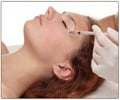Climate conditions significantly influence the dosage needed for effective cosmetic Botox treatments.

The Effect of Climate on the Dose Requirements of Botulinum Toxin A in Cosmetic Interventions
Go to source). "In countries with higher sun exposure, higher doses of Botox may be needed to achieve the same degree of forehead muscle paralysis, compared to less-sunny countries," comments lead author Kim L. Borsky, MBBS, MD, MRCS, of Stoke Mandeville Hospital, Aylesbury, UK. "Our results suggest that plastic surgeons may need to adjust their Botox dosing protocols to account for the effects of climate on the results of this cosmetic treatment."
‘Besides cosmetic uses, #Botox is also used medically to treat conditions such as chronic migraines, excessive sweating. #climatechange ’





Minimally Invasive Marvels: The Surge in Injectable Procedures
Administration of "injectables" is the most common minimally invasive cosmetic procedure performed by plastic surgeons. According to ASPS statistics, injection of neuromodulators such as botulinum toxin type A – best known by the brand name Botox – was performed more than 8.7 million times in 2022. Botox blocks nerve signals to the injected muscles, causing reversible muscle paralysis. This allows softening and relaxation of lines and wrinkles of the overlying skin.Plastic surgeons have noticed variations in the improvement achieved by Botox injections. While several factors are known to affect the response – including muscle mass, gender, age, and ethnicity – other, unidentified factors may also play a role.
Could climate contribute to differences in the response to cosmetic Botox injection? Dr. Borsky and colleagues compared outcomes of Botox treatment in two groups of patients: a "high-sun" group of 292 women in the Mediterranean island nation of Malta and a "low-sun" group of 231 women treated in London, UK. Patients in Malta were treated during the summer months while the UK patients were treated in the winter months.
The patients underwent Botox injections into the glabellar muscles of the lower forehead; all treatments were performed by experienced plastic surgeons following a standardized technique. At follow-up visits, patients received "top-up" doses as needed to achieve "full clinical paralysis." Total Botox dose needed to achieve this result was compared between the high-sun and low-sun groups.
The results showed a higher average total Botox dose in the high-sun group: 29.2 versus 27.3 units. Patients in Malta also received a higher average top-up dose: 2.24 versus 1.98 units. The differences in Botox dose remained significant after adjustment for age and other factors.
Advertisement
The researchers note that the small difference in their study isn’t likely to have a large impact on treatment costs, but it may have implications for training and treatment. "Rigid protocols about doses and distributions may lead to undertreatment if applied in sunnier climates," Dr. Borsky and coauthors conclude. "Treatment protocols may need to account for the climate in which treatments are being undertaken to achieve more predictable results."
Advertisement
- The Effect of Climate on the Dose Requirements of Botulinum Toxin A in Cosmetic Interventions - (https://journals.lww.com/plasreconsurg/fulltext/2024/07000/the_effect_of_climate_on_the_dose_requirements_of.14.aspx)
Source-Eurekalert













